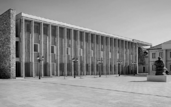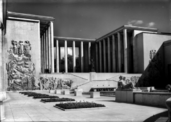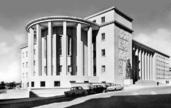State Modernism
State Modernism is an architectural style which originated in Aurora and the New World in the late 15th Century AC and which primarily deals with governmental, judicial, or other kinds of public buildings.
An offshoot of modernist architecture, state modernism has been described as a synthesis of neoclassical formal elements with a modernist ethos. Facades are often characterized by colonnades and bare or engraved epistyles, but complex elements such as capitals and triangular pediments are eschewed in favor of simplicity of design. Flat roofs reinforce a sense of horizontal extension while columns, rectangular or cylindrical in shape, emphasize verticality – in short, as with Classical Elyrian architecture, aesthetic monumentality reinforces state authority.



